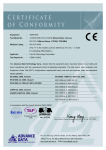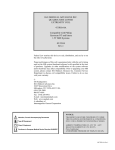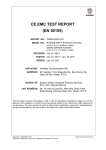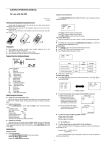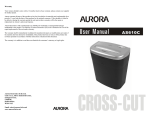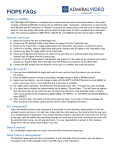Download Aurora AX-582BL
Transcript
AURORA OPERATING MANUAL
MODE 3
For use with AX-582
Twin-line scientific calculator.
MODE MODE
Printed in China
9220250
Removing and Replacing the Calculator’s Cover
Always slide the keyboard end of the unit into the cover first. Never slide the
display end of the unit into the cover.
Holding the cover as shown in the illustration, slide the unit out of the cover
before use. Picture………1
Holding the cover as shown in the illustration, slide the unit out of the cover
after use. Picture………2
MODE MODE MODE
MODE MODE MODE 1
MODE MODE MODE 2
MODE MODE MODE 3
Precautions
MODE MODE MODE
Don’t expose the machine to water, direct sunlight, extremely hot or cold
temperatures or dusty environments.
Don’t drop the machine or subject it to heavy impact.
Use a soft cloth to clean the machine. Do not use detergents.
MODE 1
MODE MODE MODE
MODE 1
Two-line Display
■ Input Capacity
The two-line display makes it possible to view both the calculation formula and
its result at the same time.
The upper line shows the calculation formula.
The lower line shows the result.
Before Starting Calculations ...
Mode
Mode
Indicator
Operation
Calculation Mode
Normal calculations
Standard deviation
calculations
COMP
-
MODE 1
SD
SD
MODE 2
Regression calculations
REG
REG
MODE 3
Degrees
DEG
D
MODE MODE 1
Radians
RAD
R
MODE MODE 2
Grads
GRA
G
MODE MODE 3
NORM1
-
MODE MODE MODE 3
1
NORM2
-
MODE MODE MODE 3
2
FIX
Fix
MODE MODE MODE 1
SCI
Sci
MODE MODE MODE 2
Display Modes
Number of decimal
place specification
Number of significant
digit specification
Use ► and ◄ to move the cursor to the location you want.
Press DEL to delete the number or function at the current cursor position.
Press SHIFT INS to change to an insert cursor □. Inputting something while
the insert cursor is on the display inserts the input at the insert cursor
position.
Pressing SHIFT INS , or = returns to the normal cursor from the insert
cursor.
■ Replay Function
Angle Unit Modes
Exponential notation
(canceling FIX and SCI
specification)
The memory area used for calculation input can hold 79“steps”. One step
is taken up each time you press a number key or arithmetic operator key (+, , ×, ÷). A SHIFT or ALPHA key operation does not take up a step, so
inputting SHIFT 3√ takes up only one step.
You can input up to 79 steps for a single calculation. Whenever you input the
73rd step of any calculation, the cursor changes from “ _” to “■” to let you
know memory is running low. If you need to input more than 79 steps, you
should divide your calculation into two or more parts.
Pressing the Ans key recalls the last result obtained, which you can use in a
subsequent calculation. See “Answer Memory” for more information about
using the Ans key.
■ Making Corrections During Input
■ Modes
Application
Press 1~3 key to select
Inv Quad the status of Power
regression, Inverse
2
3
regression or Quadratic
regression.
Press 1~3 key to select
Deg Rad Gra current calculating
angle unit: Degrees,
1
2
3
radians or grads.
Press 1~3 key to settle
No. of Decimal Place
Fix Sci Norm specification, No. of
significant Digit
1
2
3
Specification or
Exponential Notation.
Press 0~9 to select
Decimal Place
Fix 0~9 ?
specification.
Press 0~9 to select No.
of significant digital
Sci 0~9 ?
specification.
Press 1~2 to select
exponential display
status and exit
Decimal Place
Norm 1~2 ?
Specification and
Significant Digital
Specification status.
Press 1~2 to select and
make sure the display
ab/c
d/c
mode when the
1
2
calculating result is
more than 1.
Dot
Comma Press 1~2 to select the
display status of
1
2
Separator Symbols.
Pwr
1
Every time you perform a calculation, the replay function stores the
calculation formula and its result in replay memory. Pressing the ▲key
displays the formula and result of the calculation you last performed.
Pressing ▲again back steps sequentially (new-to-old) through past
calculations.
Pressing the ► or ◄ key while a replay memory calculation is on the display
changes to the editing screen.
Pressing the ► or ◄ key immediately after you finish a calculation displays
the editing screen for that calculation.
Pressing CA does not clear replay memory, so you can recall the last
calculation even after you press CA .
Replay memory capacity is 128 bytes for storage of both expressions and
results.
Replay memory is cleared by any of the following actions.
1. When you press the ON key.
2. When you initialize modes and settings by pressing SHIFT CLR
2
(Mode) = .
3. When you change from one calculation mode to another.
4. When you turn off the calculator.
■ Error Locator
Note!
Mode indicators appear in the upper part of the display.
The COMP, SD, and REG modes can be used in combination with the angle
unit mode.
To return the calculation mode and setup to the initial defaults shown below,
press SHIFT CLR 2 (MODE) =
Calculation Mode: COMP
Angle Unit: Deg
Exponential Display Format: Norm 1
Fraction Display Format: a b/c
Decimal Point Character: Dot
Be sure to check the current calculation mode (SD, REG, COMP) and angle
unit setting (Deg, Rad, Gra) before calculating.
A multi-statement is an expression that is made up of two or more smaller
expressions, which are joined using a colon ( : ).
Example: To add 2 + 3 and then multiply the result by 4
2 + 3 ALPHA : Ans ×
MODE
MODE 3
Display
4 =
2+3
D
▲
5. Disp
=
Ans×4
D▲
20.
■ Exponential Display Formats
This calculator can display up to 10 digits. Larger values are automatically
displayed using exponential notation. In the case of decimal values, you can
select between two formats that determine at what point exponential notation is
used.
Pressing MODE MODE MODE 3 1 (or 2 ), press 1 to select Norm 1 or 2
for Norm 2.
Norm 1
With Norm 1, exponential notation is automatically used for integer values
with more than 10 digits and decimal values with more than two decimal
places.
Norm2
With Norm 2, exponential notation is automatically used for integer values
with more than 10 digits and decimal values with more than nine decimal
places.
All of the examples in this manual show calculation results using the Norm
■ MODE Key Operation and Display
Operation
Pressing ► or ◄ after an error occured displays the calculation with the
cursor positioned at the location where the error occurred.
■ Multi-statements
Instruction
Press1~3 key to select
COMP SD REG the status of Normal
Calculation, Standard
1
2
3
Deviation or
Regression.
Press 1~3 key to select
Lin Log Exp the status of Linear
regression, Logarithmic
1
2
3
regression or
exponential regression.
1
1 format.
660 ÷ 880 SHIFT %
■ Decimal Point and Separator Symbols
You can use the display setup (Disp) screen to specify the symbols you want for
the decimal point and 3-digit separator.
To change the decimal point and separator symbol setting, press the MODE
MODE MODE MODE 1 ►.
Press the number key( 1 or 2 )that corresponds to the setting you want to
use.
1 (Dot): Period decimal point, comma separator
2 (Comma): Comma decimal point, period separator
●
75.
D
●
2500×15%+ ▲
2,875.
Example 4: To discount 3500 by 25% (2625)
D
3500×25% - ▲
2,625.
Example 5: If 300 grams are added to a test sample originally weighing 500
grams, what is the percentage increase in weight ? (160%)
300 + 500 SHIFT %
D
▲
300+500%
Example 6: If the temperature changes from 40℃
to 46℃, what percentage did
160.
it rise? How about to 48℃? (15%, 20%)
3500 × 25 SHIFT % -
●
Perform the following key operation when you want to initialize the calculation
mode and setup, and clear replay memory and variables.
SHIFT CLR 3 (All) =
●
Basic Calculations
46 - 40 SHIFT %
■ Arithmetic Calculations
●
●
●
●
●
●
●
●
◄ ◄ ◄ ◄ ◄ ◄ 8 =
1
●
●
2
5
●
●
2.258
●
Example 3: 1
2.258
Example 2: To perform the following calculation:
D
12°34′56″ ×3.45
12˚34˚56˚×3. ▲→
12 ° ′ ″ 34 ° ′ ″ 56 ° ′ ″ × 3.45 =
43˚24˚31.2
■ FIX, SCI, RND
●
Example 1: 200÷7×14 =
D
D
200 ÷ 7 × 14 =
200÷7×14
MODE MODE MODE 1 3
1」2+1.6
400.
Example 1:
2.75 2
3 (Decimal ↔ Fraction)
4
D FIX
(Internal calculation
2.75
200 ÷ 7 =
28.571
× 14 =
Example 2: 1
2
0.5
400.000
The following performs the same calculation using the specified number of
decimal places.
D
D FIX
2.75
200 ÷ 7 =
200÷7
SHIFT Round
200÷7
D FIX
( Internal rounding )
ab/c
1」2
ab/c
1」2
× 14 =
●
●
D▲
1」2.
●
D▲
D
1」2」3
●
●
●
●
▲
●
●
1」2」3.
1」2」3
●
▲
5」3.
D
●
●
Press MODE MODE MODE 3 1 to clear the Sci specification.
1」2」3
Whenever you press = after inputting values or an expression, the calculated
result automatically updates Answer Memory contents by storing the result.
In addition to = , Answer Memory contents are also updated with result
whenever you press SHIFT % , M+ , SHIFT M- or SHIFT STO followed by
a letter (A through F, or M, X, or Y).
You can recall Answer Memory contents by pressing Ans .
Answer Memory can store up to 12 digits for the mantissa and two digits for
the exponent.
Answer Memory contents are not updated if the operation performed by any of
the above key operations results in an error.
■ Consecutive Calculations
●
▲
1」2」3.
You can use the display setup (Disp) screen to specify the display format
when a fraction calculation result is greater than one. Pressing MODE
MODE MODE MODE 1 .
Press the number key( 1 or 2 )that corresponds to the setting you
want to use.
1 (ab/c):Mixed fraction
2 (d/c):Improper fraction
An error occurs if you try to input a mixed fraction while the d/c display
format is selected.
●
You can use the calculation result that is currently on the display (and also
stored in Answer Memory) as the first value of your next calculation. Noted
that pressing an operator key while a result is displayed causes the displayed
value to change to Ans, indicating it is the value that is currently stored in
Answer Memory.
The result of a calculation can also be used with a subsequent Type A
function(x2, x3, x-1, x!), +, -, ^(xy), x√, ×,÷, nPr , nCr and ° ′ ″.
■ Independent Memory
●
Values can be input directly into memory, added to memory, or subtracted
from memory. Independent memory is convenient for calculating cumulative
totals.
● Independent memory uses the same memory area as variable M.
● To clear independent memory (M), input 0 SHIFT STO M (M+).
● Example:
M
D
▲
23+9→M
23 + 9 = 32 23 + 9 SHIFT STO M
32.
■ Percentage Calculations
●
●
Press MODE MODE MODE 3 1 to clear the Fix specification.
Example 2: 1÷3, displaying result with two significant digits (Sci 2).
MODE MODE MODE 2 2
D SCI
▲
1÷3
1 ÷ 3 =
3.3×10-01
■ Answer Memory
1」2.
D
SHIFT d/c
399.994
Memory Calculations
▲
Mixed Fraction ↔ Improper Fraction Conversion
SHIFT d/c
▲
Ans×14
0.5
D
Example: 2
5
1
3
3
b
b
1 a /c 2 a /c 3 =
▲
28.571
D FIX
▲
(Fraction ↔ Decimal)
1」2
▲
28.571
D
▲
2」3」4.
11」4.
1 ab/c 2 =
▲
Ans×14
D
2.75
▲
200÷7
D FIX
continues using 12 digits.)
▲
2.75
200÷7×14 ▲
400.000
▲
Results of calculations that mix fraction and decimal values are always
decimal.
Decimal ↔ Fraction Conversion
SHIFT d/c
●
▲
1」2.
D
ab/c
●
D▲
●
1 ab/c 2 + 1.6 =
1.6 2.1
2.75 =
●
2˚15˚28.8
2.258
2.1
●
▲
D FIX
2
●
D
2.258
° ′ ″
▲
2」4
D▲
2.258
° ′ ″
2 ab/c 4 =
1
4 2
48-40%
▲
You can perform sexagesimal calculations using degrees (hours), minutes,
and seconds, and convert between sexagesimal and decimal values.
Example 1: To convert the decimal value 2.258 to a sexagesimal value and
then back to a decimal value.
2.258 =
2」3+1」4」5 ▲
2」7」15.
Example 2: 2
D
20.
D
15
▲
■ Degrees, Minutes, Seconds Calculations
Fraction Calculations
Use the COMP mode for fraction calculations. Values are displayed in
decimal format automatically whenever the total number of digits of a
fractional value (integer + numerator + denominator + separator marks)
exceeds 10.
b
b
b
Example 1: 2
4
7 2 a /c 3 + 1 a /c 4 a /c 5 =
3
D
46-40%
15.
Use the COMP mode for basic calculations.
Negative values inside of calculations must be enclosed within parentheses.
Sin -1.23 → sin ( (-) 1.23 )
It is not necessary to enclose a negative exponent within parentheses.
Sin 2.34×10-5 → sin 2.34 EXP (-) 5
Example 1:3×(5×10 9)=1.5×10 8
D▲
3×5E–9
3 × 5 EXP (-) 9 =
1.5×10-08
Example 2:5×(9+7)=80
D▲
5×(9+7)
5× ( 9 + 7 ) =
80.
You can skip all ) operations before = .
■ Fraction Operations
●
▲
Example 3: To add 15% onto 2500 (2875)
2500 × 15 SHIFT % +
■ Initializing the Calculator
D
660÷880%
Use the COMP mode for percentage calculations.
Example 1: To calculate 12% of 1500(180)
D
1500×12% ▲
180.
1500 × 12 SHIFT %
Example 2: To calculate what percentage of 880 is 660(75%)
M
53-6M+
2
D
▲
47.
53 – 6 = 47
53 - 6 M+
D
7 SHIFT
-)45×2 = 90
M
45 × 2 SHIFT M-
45×2M-
D
▲
90.
M
(Total) -11
D▲
M=
RCL M
√ 123 =
●
Example 4: 123+302=1023
●
123 + 30
Example 5: 12 =1728
●
●
●
There are nine variables (A through F, M, X and Y), which can be used to store
data, constants, results, and other values.
Use the following operation to delete data assigned to a particular variable: 0
SHIFT STO A . This operation deletes the data assigned to variable A.
Perform the following key operation when you want to clear the values
assigned to all of the variables.
SHIFT CLR 1 (Mcl) =
●
Example: 193.2 ÷ 23 = 8.4
193.2 ÷ 28 = 6.9
193.2 SHIFT STO A ÷ 23 =
●
( 3
●
D▲
Ans÷23
Example 6:
) X-1 =
D
●
6.9
●
●
●
Example 2: cos ( rad) = 0.5
3
R
Cos ( SHIFT π ÷ 3 ) =
●
Example 3: cos-1
●
●
▲
Cos (π÷3)
0.5
2
2
=0.25π(rad) ( =
●
→(R)
MODE MODE 2
R
●
●
●
0.25
●
210.
Press SHIFT DRG► to display the following menu.
D R G
1 2
3
Pressing 1 , 2 or 3 converts the displayed value to the corresponding
angle unit.
Example:To convert 4.25 radians to degrees.
MODE MODE 1 →(D)
D
▲
4.25
243.5070629
r
Calculation results are automatically assigned to variables E and F.
Example 1: To convert polar coordinates(r = 2,θ=60˚)to rectangular
coordinates(x , y) (Deg).
x =1
→(D)
D
SHIFT Rec ( 2 , 60 ) =
▲
Rec(2,60)
1.
D
tan-1 0.741 ▲
36.53844577
y=1.732050808
RCL F
▲
F=
D
1.732050808
■ Hyperbolic/Inverse Hyperbolic Functions
●
●
Example 1: sinh 3.6 = 18.28545536
D
hyp sin 3.6 =
D
■ Coordinate Conversion (Pol (x , y) , Rec (r , θ) )
MODE MODE 1
●
▲
10C4
4.25 SHIFT DRG► 2 ( R ) =
▲
Example 4: tan-10.741 = 36.53844577°
SHIFT tan-1 0.741 =
D
▲
7P4
840.
Example 11: To determine how many different 4-member groups can be
organized in a group of 10 individuals(210)
→(R)
SHIFT cos-1 ( √ 2 ÷ 2 ) = Ans ÷ SHIFT π =
Ans÷π
D
▲
3π
9.424777961
Example 10: To determine how many different 4-digit values can be produced
using the numbers 1 through 7 Numbers cannot be duplicated within the same
4-digit value (1234 is allowed, but 1123 is not).(840)
(rad)
4)
MODE MODE 2
0.96
■ Angle Unit Conversion
Sin 63˚ 52˚41 →
0.897859012
Sin 63 ° ′ ″ 52 ° ′ ″ 41 ° ′ ″ =
D
(The above value is a sample only. Results differ each time.)
Example 9: 3π= 9.424777961
10 nCr 4 =
→(D)
D ▲
MODE MODE 1
▲
Ran #
7 SHIFT nPr 4 =
●
40,320.
Example 8: To generate a random number between 0.000 and 0.999
■ Trigonometric/Inverse Trigonometric Functions
To change the default angle unit (degrees, radians, grads), press the MODE
MODE. Press the number key( 1 , 2 or 3 )that corresponds to the angle
unit you want to use.
(90˚=π/2 radians = 100 grads)
Example 1: sin63˚52′41″= 0.897859012
D
▲
8!
3 SHIFT π =
Use the COMP mode for Scientific Function calculations.
Certain types of calculations may take a long time to complete.
Wait for the result to appear on the display before starting the next calculation.
π= 3.14159265359
▲
12.
SHIFT Ran# =
▲
D
( 3-1 - 4-1 )-1
X-1
Example 7: 8!= 40320
8 SHIFT X! =
8.4
A÷28
1,728.
1
12
1 1
3 4
X-1- 4
D
▲
123
12 X3 =
Scientific Function Calculations
●
1,023.
-11.
ALPHA A ÷ 28 =
●
●
●
●
D
▲
123+302
=2
X
3
■ Variables
●
▲
7x√123
1.988647795
x
▲
sinh 3.6
18.28545536
Press RCL E to display the value of x ,or RCL F to display the value of y .
Example 2: To convert rectangular coordinates(1, √3)to polar coordinates(r
,θ) (Rad).
r=2
Example 2: sinh-1 30 = 4.094622224
R
▲
Pol(1,√3)
Pol ( 1 , √ 3 ) =
2.
D
hyp SHIFT sin-1 30 =
▲
sinh-1 30
4.094622224
θ=1.047197551
RCL F
●
●
●
D
▲
log 1.23
0.089905111
lne = 1
ln ALPHA e =
ln 90
ln e
▲
●
56088 = ENG
●
●
▲
e 10
22,026.46579
■ Standard Deviation
●
●
●
●
Example 4: 101.5 = 31.6227766
10
D
1.5
31.6227766
4
Example 5: 2 =16
2 ^ 4 =
2^4
▲
D
16.
■ Square Roots, Cube Roots, Roots, Squares, Cubes, Reciprocals,
Factorials, Random Numbers,π, and Permutation/ Combination
●
D
●
Example 3:
7
x
xσn
xσn-1
=
D
√5+ 3√(-27) ▲
- 1.290024053
3
1
7
n
√2+√3×√5 ▲
5.287196909
Example 2: 3 5 3 27 = - 1.290024053
SHIFT 3√ 5 + SHIFT 3√ ( (-) 27 )
Press MODE 2 to enter the SD Mode for statistical calculations using
standard deviation.
Always start data input with SHIFT CLR
1 (Scl) = to clear statistical
memory.
Input data using the key sequence shown below.
‹x - data › DT
Input data is used to calculate values for n ,∑x ,∑x2 , x , xσn and xσn-1 ,
which you can recall using the key operations noted nearby.
To recall this type of value:
∑x2
∑x
Example 1: 2 3 5 5.287196909
√ 2 + √ 3× √ 5 =
●
D
Statistical Calculations
D
SHIFT 10 1.5 =
D
▲
0.08125
81.25×10-03
0.08125 = ENG
1.
▲
▲
56.088×1003
Example 2: To convert 0.08125 grams to milligrams
Example 3: e = 22026.46579
x
56088
D
10
SHIFT ex 10 =
●
Example 1: To convert 56,088 meters to kilometers
D
4.49980967
▲
Press RCL E to display the value of r or RCL F to display the value of θ.
■ Engineering Notation Calculations
Example 2: ln 90 (= loge90) = 4.49980967
ln 90 =
●
1.047197551
Example 1: log 1.23=0.089905111
log 1.23 =
▲
F=
■ Common and Natural Logarithms/ Antilogarithms
R
123 (=123 )=1.988647795
3
Perform this key operation:
SHIFT S-SUM 1
SHIFT S-SUM 2
SHIFT
SHIFT
SHIFT
SHIFT
S-SUM
S-VAR
S-VAR
S-VAR
3
1
2
3
●
Example: To calculate xσn-1, xσn, x , n, ∑x and∑x2 for the following data :
55, 54, 51, 55, 53, 53, 54, 52.
In the SD Mode:
SHIFT CLR 1 (Scl) = (Stat clear)
SD
D
n=
1.
55 DT
Regression coefficient B
SHIFT S-VAR 2
Regression calculation other than quadratic regression
Correlation coefficient r
SHIFT S-VAR 3
xˆ
yˆ
Each time you press DT to register your input, the number of data input
up to that point is indicated on the display (n value).
54 DT 51 DT 55 DT
n=
53 DT DT 54 DT 52 DT
Sample Standard Deviation(xσn-1)=1.407885953
SD
●
D
8.
SD
SHIFT S-VAR 2 =
Arithmetic Mean (
xσn
x ) = 53.375
SD
D
1.316956719
SD
SHIFT S-VAR 1 =
Number of Data ( n ) = 8
SHIFT S-SUM 3 =
●
D
●
D
x
xˆ 1
xˆ 2
SHIFT S-VAR 1
yˆ
SHIFT S-VAR 3
53.375
n
SD
∑x
8.
SD
∑x2
D
427.
SD
D
22,805.
●
●
●
xy n x y .
n 1
SHIFT CLR 1 (Scl) = (Stat clear)
REG
n=
D
1.
10 , 1003 DT
Each time you press DT to register your input, the number of data input
up to that point is indicated on the display (n value).
15 , 1005 DT 20 , 1010 DT
REG
n=
D
5.
25 , 1011 DT 30 , 1014 DT
Regression Coefficient A=997.4
SHIFT S-VAR ► ► 1 =
A
B
SHIFT S-VAR ► ► 2 =
REG
D
REG
D
997.4
Regression Coefficient B=0.56
0.56
Correlation Coefficient r = 0.982607368
SHIFT S-VAR ► ► 3 =
REG
r
D
0.982607368
Atmospheric Pressure at 18°C =1007.48
REG
18
18 SHIFT S-VAR ► ► ► 2 =
Press MODE 3 to enter the REG Mode and then select one of the following
regression types( 1 2 or 3 )。
1 (Lin): Linear regression
2 (Log): Logarithmic regression
3 (Exp): Exponential regression
1 (Pwr): Power regression
2 (lnv): Inverse regression
3 (Quad): Quadratic regression
Always start data input with SHIFT CLR
1 (Scl) = to clear statistical
memory.
Input data using the key sequence shown below.
<x - data > , <y - data > DT
The values produced by a regression calculation depend on the values input,
and results can be recalled using the key operations shown in the table below.
To recall this type of value:
Perform this key operation:
∑x2
SHIFT S-SUM 1
∑x
SHIFT S-SUM 2
n
SHIFT S-SUM 3
∑y2
SHIFT S-SUM 1
∑y
SHIFT S-SUM 2
∑x y
SHIFT S-SUM 3
3
∑x
SHIFT S-SUM 1
∑x2 y
SHIFT S-SUM 2
∑x4
SHIFT S-SUM 3
SHIFT S-VAR 1
x
xσn
SHIFT S-VAR 2
xσn-1
SHIFT S-VAR 3
y
1014hPa
MODE 3 1 (Lin)
Press 2 to exit data input without registering the value you just input.
Press 1 if you want to register the value you just input, without saving it in
memory. If you do this, however, you will not be able to display or edit any of
the data you have input.
To delete data you have just input, press SHIFT CL .
yσn
yσn-1
Regression coefficient A
1011hPa
30°C
In the REG Mode:
■ Regression Calculations
●
1010hPa
25°C
Edit OFF ESC
1
2
●
1005hPa
20°C
determination r2 and sample covariance
DT DT inputs the same data twice.
You can also input multiple entries of the same data using SHIFT ; . To input
the data 110 ten times, for example, press
110 SHIFT ; 10 DT.
● You can perform the above key operations in any order, and not necessarily
that shown above.
● While inputting data or after inputting data, you can use the ▲ and ▼ keys to
scroll through data you have input. If you input multiple entries of the same
data using SHIFT ; to specify the data frequency (number of data items) as
described above, scrolling through data shows both the data item and a
separate screen for the data frequency (Freq).
You can then edit the displayed data, if you want. Input the new value and
then press the = key to replace the old value with the new one.
● Pressing the DT key instead of = after changing a value on the display
registers the value you input as a new data item, and leaves the old value as it
is.
● You can delete a data value displayed using ▲ and ▼ by pressing SHIFT CL
. Deleting a data value causes all values following it to be shifted up.
● Data values you registered are normally stored in calculator memory. The
message “Data Full” appears and you will not be able to input any more data if
there is no memory left for data storage. If this happens, press the = key to
display the screen shown below.
●
1003hPa
15°C
Perform linear regression to determine the regression formula terms and
correlation coefficient for the data nearby. Next, use the regression formula to
estimate atmospheric pressure at 18°C and temperature at 1000 hPa. Finally,
calculate the coefficient of
Data Input Precautions
●
Atmospheric Pressure
Temperature
10°C
D
Sum of Squares of Values (∑x2 ) = 22805
SHIFT S-SUM 1 =
SHIFT S-VAR 2
The values in the above tables can be used inside of expressions the same
way you use variables.
Linear Regression
The regression formula for linear regression is: y = A+Bx。
● Example: Atmospheric Pressure vs. Temperature
Sum of Values (∑x ) = 427
SHIFT S-SUM 2 =
SHIFT S-VAR 2
The following table shows the key operations you should use to recall results
in the case of quadratic regression.
To recall this type of value:
Perform this key operation:
Regression coefficient C
SHIFT S-VAR 3
xσn-1
1.407885953
Population Standard Deviation (xσn) = 1.316956719
SHIFT S-VAR 3 =
SHIFT S-VAR 1
D
yˆ
1,007.48
Temperature at 1000 hPa =4.642857143
REG
D
REG
D
1000 x
ˆ
4.642857143
1000 SHIFT S-VAR ► ► ► 1 =
Coefficient of Determination =0.965517241
SHIFT S-VAR ► ► 3 x2 =
r2
0.965517241
Sample Covariance =35
( SHIFT S-SUM ► 3 SHIFT S-SUM 3 × SHIFT S-VAR 1 ×
SHIFT S-VAR ► 1 ) ÷
REG
(∑xy-n×
( SHIFT S-SUM 3 - 1 ) =
●
SHIFT S-VAR 2
SHIFT S-VAR 3
SHIFT S-VAR 1
4
×
D
y )÷→
35.
Logarithmic, Exponential, Power, and Inverse Regression
● Use the same key operations as linear regression to recall results for these
types of regression.
● The following shows the regression formulas for each type of regression.
Logarithmic Regression
y = A+B·ln x
Exponential Regression
y=A·e B·x(ln y=ln A+B x)
Power Regression
y=A·x B(ln y=ln A+B ln x)
Inverse Regression
y=A+B·1/x
●
SHIFT S-VAR 1
x
Quadratic Regression
The regression formula for quadratic regression is: y=A+Bx+Cx2
Example:
●
●
xi
yi
29
1.6
50
23.5
74
38.0
103
46.4
118
√,3√,log, ln, ex, 10x, sin, cos, tan, sin-1, cos-1, tan-1, sinh, cosh, tanh,
sinh-1, cosh-1, tanh-1, (-)
⑦ Abbreviated multiplication format in front of Type B functions: 2√3, Alog2 etc.
⑧ Permutation and combination: nPr, nCr
⑨ ×, ÷
⑩ +, -
48.0
Perform quadratic regression to determine the regression formula terms for
the data nearby. Next, use the regression formula to estimate the values for y
ˆ
(estimated value of y) for xi=16 and x
ˆ (estimated value of x) for yi=20
In the REG Mode:
MODE 3 ► 3 (Quad)
SHIFT CLR 1 (Scl) = (Stat clear)
29 , 1.6 DT 50 , 23.5 DT 74 , 38.0 DT
REG D
n=
103 , 46.4 DT 118 , 48.0 DT
5.
Regression Coefficient A= -35.59856934
SHIFT S-VAR ► ► 1 =
REG
A
●
●
REG
B
This calculator uses memory areas, called “stacks,” to temporarily store values
(numeric stack) and commands (command stack) according to their precedence
during calculations. The numeric stack has 10 levels and the command stack has 24
levels. A stack error (Stack ERROR) occurs whenever you try to perform a
calculation that is so complex that the capacity of a stack is exceeded.
● Example:
D
1.495939413
Regression Coefficient C= -6.71629667×10-3
SHIFT S-VAR ► ► 3 =
yˆ
REG
2 ×( ( 3 + 4 × ( 5 + 4 ) ÷ 3 )÷ 5 )+ 8 =
D
C
-6.71629667×10-03
16 SHIFT S-VAR ► ► ► 3 =
yˆ
REG
②
1
when xi is 16 = -13.38291067
16
Operations of the same precedence are performed from right to left. exln 120
→ex{ln(√120)}
Other operations are performed from left to right.
Operations enclosed in parentheses are performed first.
■ Stacks
D
- 35.59856934
Regression Coefficient B=1.495939413
SHIFT S-VAR ► ► 2 =
●
D
- 13.38291067
REG
20
xˆ 1
D
47.14556728
xˆ 2 when yi is 20 =175.5872105
20 SHIFT S-VAR ► ► ► 2 =
REG
20
xˆ 2
D
●
●
5 6
●
DT DT inputs the same data twice.
You can also input multiple entries of the same data using SHIFT ; . To input
the data “20 and 30” five times, press 20 , 30 SHIFT ; 5 DT .
The above results can be obtained in any order, and not necessarily that
shown above.
Precautions when editing data input for standard deviation also apply for
regression calculations.
1
×
②
3
2
(
③
4
3
(
④
5
4
+
⑤
4
5
×
6
(
7
+
┆
Calculations are performed in sequence according to “Order of Operations”.
Commands and values are deleted from the stack as the calculation is
performed.
■ Input Ranges
Internal digits: 12
Accuracy*: As a rule, accuracy is ±1 at the 10th digit.
Functions
sinx
If calculation results are not what you expect or if an error occurs, perform the
following steps.
1. Press SHIFT CLR 2 (Mode) = to initialize all modes and settings.
2. Check the formula you are working with to confirm it is correct.
3. Enter the correct mode and try performing the calculation again.
If the above steps do not correct the problem, press the ON key. The calculator
performs a self-check operation and deletes all data stored in memory if any
abnormality is detected. Make sure you always keep written copies of all
important data.
cosx
tanx
■ Error Messages
sin-1x
The calculator is locked up while an error message is on the display. Press CA
to clear the error, or press ◄ or ► to display the calculation and correct the
problem. See“Error Locator” for details.
cos-1x
tan-1x
sinhx
coshx
sinh-1x
■ Math ERROR
Causes
● Calculation result is outside the allowable calculation range.
● An attempt to perform a function calculation using a value that exceeds the
allowable input range.
cosh-1x
● An attempt to perform an illogical operation (divided by zero, etc.)
tanhx
Action
● Check your input values and make sure they are all within the allowable
ranges. Pay special attention to values in any memory areas you are using.
-1
tanh x
Log x/lnx
■ Stack ERROR
●
●
Causes
● The capacity of the numeric stack or operator stack is exceeded.
Action
● Simplify the calculation. The numeric stack has 10 levels and the operator
stack has 24 levels.
● Divide your calculation into two or more separate parts.
10x
●
Cause
● An attempt to perform an illegal mathematical operation.
Action
● Press ◄ or ► to display the calculation with the cursor located at the
location of the error and make required corrections.
Calculations are performed in the following order of precedence.
1 Coordinate transformation: Pol (x , y), Rec (r , θ)
② Type A functions:
With these functions, the value is entered and then the function key is
pressed.
x3 , x2 , x-1 , x! , ° ′ ″
x , x1 , x2 , y
ˆ
0<|x|<1.111111112×1012
DEG
0<|x|<10×1011
RAD
0<|x|<1.745329252×1010
GRA
0<|x|<1.111111112×1012
DEG
Same as sinx, except when |x|=(2n-1)×90
RAD
Same as sinx, except when |x|=(2n-1)×π/2
GRA
Same as sinx, except when |x|=(2n-1)×100
0≦|x|≦1
0≦|x|≦9.999999999×1099
0≦|x|≦230.2585092
0≦|x|≦4.999999999×1099
0≦|x|≦9.999999999×1099
0≦|x|≦9.999999999×10-1
0< x
-9.999999999×1099≦x≦99.99999999
x
0 ≦ x < 1×10100
x
|x|<1×1050
1/x
|x|<1×10100
3
|x|<1×10100
x
x≠0
0 ≦ x ≦ 69 (x is an integer)
nPr
0 ≦ n < 10×1099, r ≦ n (n , r are integers)
1 ≦ { n ! /( n - r ) ! } ≦ 9.999999999×1099
nCr
0 ≦ n < 10×1099 , r ≦ n (n , r are integers)
1 ≦ { n ! /( n - r ) ! } ≦ 9.999999999×1099
Rec ( r , θ)
° ′ ″
←
° ′ ″
5
0<|x|<1.745329252×1010
2
Pol (x, y)
Angle unit conversions
③ Powers and roots: ^(xy),x√
④ ab/c
⑤ Abbreviated multiplication format in front of π, e (natural logarithm base),
memory name, or variable name: 2π, 5A,π A etc.
⑥ Type B functions:
With these functions, the function key is pressed and then the value is
entered.
RAD
GRA
-9.999999999×1099≦x≦230.2585092
x!
■ Order of Operations
Input Range
DEG 0<|x|<10×1011
x
e
■ Syntax ERROR
●
Command Stack
2
175.5872105
■ When you have a problem………
●
7
1
Technical Information
●
⑤
┆
Data Input Precautions
●
●
④
4
Numeric Stack
xˆ 1 when yi is 20 =47.14556728
20 SHIFT S-VAR ► ► ► 1 =
③
1 2 3
|x| , |y| ≦ 9.999999999×1099
(x2 + y2) ≦ 9.999999999×1099
0 ≦ r ≦ 9.999999999×1099
θ: Same as sinx
|a| , b , c < 1×10100
0≦b,c
|x| < 1×10100
Decimal ↔ Sexagesimal Conversions
0°0°0°≦ |x| ≦ 999999°59°59°
^ ( xy )
x
y
x > 0: -1×10100 < y log x < 100
x=0: y > 0
x < 0: y = n ,
1 (n is an integer)
2100
n 1
However: -1×10 < y log |x| < 100
y>0: x≠0
-1×10100 < 1/x log |y| < 100
y=0:x>0
1
y < 0 : x = 2n+1 , ( n ≠ 0 , n is an integer)
n
However: -1×10100 < 1/x log |y| < 100
b
a /c
SD
(REG)
Total of integer, numerator, and denominator must
be 10 digits or less (including division marks).
x, y
|x| < 1×1050
xσn , yσn ,
|y| < 1×1050
|n| < 1×10100
A , B , r : n≠0
xσn-1 , yσn-1 : n≠0 , 1
* For a single calculation, calculation error is ±1 at the 10th digit. (In the case
of exponential display, calculation error is ±1 at the last significant digit.) Errors
are cumulative in the case of consecutive calculations, which can also cause
them to become large. (This is also true of internal consecutive calculations that
are performed in the case of (^( xy ), y , x!, 3√, nPr, nCr etc.)
x
In the vicinity of a function’s singular point and point of inflection, errors are
cumulative and may become large.
Replacing the Battery
Dim figures on the display of the calculator indicate that battery
power is low. Continued use of the calculator when the battery is low
can result in improper operation. Replace the battery as soon as
possible when display figures become dim.
1.
2.
3.
4.
5.
Press SHIFT OFF to turn off power.
Remove the screw from the battery cover.
Open the battery cover.
Take out the old battery.
Place the new battery into the machine with positive pole
upward.
6. Close the battery cover .
7. Replace the screw.
8. Pressing On key to turn on the power.
Power off Automatically:
When no key is pressed for 6 minutes under Power On situation, calculator will
be powered off automatically. Press ON to turn on the machine again.
Specifications
Power Supply :
LR44*2(3.0V)
Power Consumption : 0.003W
Usable temperature : 0-40℃
Size :
L153×W80×H14 mm
Weight :
87 g (hard cover is not included)
Producer
Aurora Electronics (UK) LTD.
Unit 1 & 2 Shires Industrial Estate
Lichfield, Staffordshire, WS14 9AZ, U.K.
6







